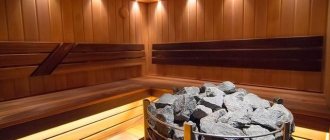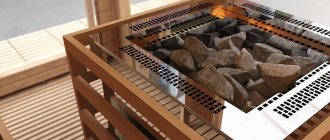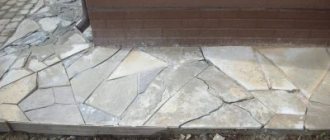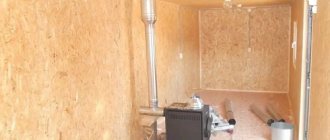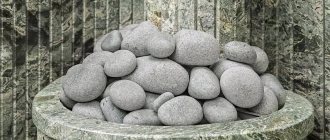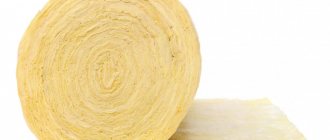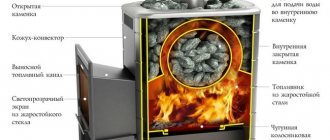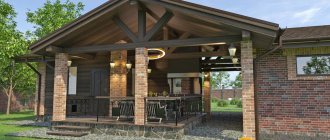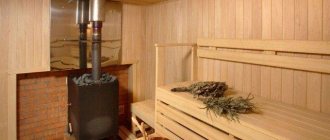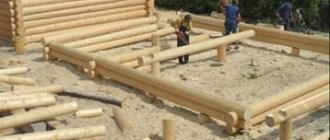Photo from Wikipedia, by Immanuel Giel
Today, there are only two bath stones that can rightfully be called “the steamer’s dream” - this is jadeite , which we have already written about, and jade . The latter is better known as a semi-precious stone - who does not know about the great love of the Chinese for it, where the best for the best is made from this stone (or was made while the emperors ruled the Celestial Empire).
And the news that he is good at using a heater began to spread not so long ago - ten years ago, few people knew about it (and could afford it). Today the situation is different - anyone can buy it if they have the money. But the information... just advertising. So our article will come in handy, because we stick to the facts and stand on the side of the consumer.
Characteristics of Jade
Jade is a very beautiful stone that speaks of your wealth. Jade is not afraid of fire; the more it heats up, the longer it will give off heat. The stone does not crack, even if it is heated strongly and then cooled sharply. This procedure, on the contrary, will harden the jade. Withstands any mechanical stress. According to some reports, jade is several times stronger than steel. A very viscous stone, it has one of the highest heat capacity, high degree of density and hardness (see table below).
The main indicators that are important for the use of stone are their density and heat capacity. For convenience, see these characteristics of jade in the table.
Table. Physico-chemical characteristics of jade
| Name of the stone | Density (kg/m³) | Heat capacity, kJ/(kg K) | Average price per 1 kg (rubles) |
| Nephritis | 3300 | 1,1 | 300 |
Such characteristics of jade allow it to retain heat for a very long time, not allowing the bath to cool down, which helps save firewood by 20% and electricity by 30% compared to other stones used in heaters (gabbro, soapstone chloride, calcite). High-quality jade will serve you and your bathhouse for decades without changing its beneficial properties and appearance. At the same time, it produces light, fresh steam. Jade has long been considered a magical stone that improves health and prolongs youth.
Benefit
For centuries, jade has firmly held its position among the most useful bath stones. It is believed that it prolongs youth and has medicinal properties:
- Jade is said to cure cancer. There is no official confirmation of this statement, but it is mentioned more and more often.
- Relieves allergy symptoms and completely cures it.
- With its help you can get rid of problems with the kidneys, liver, and genitourinary system.
- Normalizes blood pressure.
- During bath procedures, warm stones are placed on bruises. The pain subsides almost immediately, and recovery accelerates.
- Helps cope with the symptoms of colds.
- It has no contraindications even for children. It is used for increased hypertonicity of the limbs and flat feet.
- Enhances regeneration, rejuvenates the body.
- And finally, it has pronounced aseptic properties.
The “magical” abilities of the stone include the ability to attract wealth into the home, facilitate quick earnings, and provide the owner with rapid advancement up the career ladder.
Flaws
Perhaps the most important disadvantage is the relatively high price. But usually jade used for jewelry has a high price, and not everyone can afford it. The color of jewelry jade is green and light blue.
In baths, jade with impurities of copper and chromium is used, which only changes the composition of the stone and does not in any way affect its properties. At the same time, the price of jade for baths and saunas is significantly lower than pure jade and ranges from 2,500 rubles per package weighing 10 kg.
When choosing jade you need to be very careful, because... Due to the high demand for it, fakes are often found; it is necessary to buy such a stone only in specialized stores.
Jade is easy to care for. It is necessary to periodically wash the stones in warm water with added soap, then rinse off the soap, dry the stones and rub with a soft, lint-free cloth for polishing. Jade is used as a stone for making various jewelry, boxes, and figurines.
How to replace dunite
Jade
What stones have properties similar to dunite? First of all, these are stones of the same family - olivinite, for example. All rocks that are part of the peridotite family are also suitable. Pyroxenites are also good in a bath, however, the most famous of them is jadeite, which is in a different price category.
If there are no close relatives, then both gabbro and porphyrite will do. If desired, you can replace it with .
Regarding what is better and what is worse... Let's start with the fact that all stones are destroyed - some earlier, others later. If you come across stones that live up to their name and are not weathered, they will last for several years, if not on an open fire. This applies to all ultramafic igneous ones listed above. Quartzite also holds up well due to its structure, although it is a metamorphic rock.
*** Well, that's all. All that remains is to wish you honest sellers and easy steam!
Find out more about bath stones:
- Other types: jadeite, jade;
- Which ones are the best, which ones to choose;
- How to install in an electric oven and how to install in a wood oven.
Properties of jade
Jade has powerful healing properties. Scientists believe that this stone can help cope with diseases such as cancer. Jade can be used by people with allergies. But all the healing properties of jade appear only when it is heated, and with increasing temperature its usefulness only increases.
It heals the kidneys, the genitourinary system, increases potency, and normalizes cardiovascular activity. Helps with urinary tract diseases; warm stones are placed on bruises or on the back for rheumatism to warm up. Very often, jade is used in specialized medical institutions for massages and physiotherapy. Jade can be used even for children in the treatment of increased hypertonicity of the limbs and flat feet. It is useful to apply warm jade to the feet at the first sign of a cold. Jade helps lower blood pressure. Jade helps to enhance regeneration, which means it rejuvenates the body, prolonging the life of the owner.
Jade has pronounced antiseptic properties. In an aquarium whose bottom is lined with jade, the water does not bloom.
Open fire, which the jadeite stone is so “afraid of,” is, on the contrary, recommended for jade. After all, the hotter this unique stone gets, the longer it will cool down and the longer the life-giving warmth will remain in your steam room.
Applications of jade
Very often used as decoration (brooches, amulets, rings). Such jewelry looks very advantageous and rich due to the decent appearance of the stone. Monuments are made from jade.
Jade is usually used as a base for lining in a heater. Small jade is usually placed on top to increase the area of evaporation. This will allow you to heat the bathhouse faster. It is rare to fill a heater entirely with jade because of its high cost. Usually it is placed at the very top as a stone that has maximum healing properties. And below you can put cheaper samples, for example, dunite or soapstone.
If you want to use this particular stone when laying it in the heater, you can use the method of combining the shapes and sizes of jade. Many bath attendants prefer large chopped jade or jade cubes, which are placed on the bottom of the heater, and the heater itself is filled with small chopped jade in combination with chopped and sawn jade. Read about the types of stones for baths and saunas in the article at the link.
Read also: How to choose a stone for a bath?
Disadvantages of Jade
Perhaps the most important disadvantage is the relatively high price. But usually jade used for jewelry has a high price, and not everyone can afford it. The color of jewelry jade is green and light blue.
In baths, jade with impurities of copper and chromium is used, which only changes the composition of the stone and does not in any way affect its properties. At the same time, the price of jade for baths and saunas is significantly lower than pure jade and ranges from 2,500 rubles per package weighing 10 kg.
When choosing jade you need to be very careful, because... Due to the high demand for it, fakes are often found; it is necessary to buy such a stone only in specialized stores.
Jade is easy to care for. It is necessary to periodically wash the stones in warm water with added soap, then rinse off the soap, dry the stones and rub with a soft, lint-free cloth for polishing. Jade is used as a stone for making various jewelry, boxes, and figurines.
Color, structure, value
Depending on the impurities, the color of the stone also changes. In nature, there are blue and yellow varieties, as well as black ones (if there is too much iron). If it has a pink tint, this indicates an admixture of magnesium, if the unsaturated green or brown tone is iron. But if the green color is bright and juicy, this is a sign of chromium impurity. There are no coloring impurities in white varieties.
In their pure form, tremolites and actinolites are transparent, uniform and monochromatic, but this happens very rarely.
Possible stripes or veins formed by hematite or chromite.
This stone is classified as semi-precious, so its cost greatly depends on whether a particular sample can be used in jewelry.
This does not concern us, because jewelry-quality pieces of rock will never end up in the bathhouse.
But, fortunately, there is enough jade in nature, from which you can either cut out finishing tiles or put them in a heater.
Chemical composition
The general formula is quite simple. If this is a variety in which there is practically no iron admixture, then it will be called tremolite, and its formula will be: Ca₂Mg₅[Si₄O₁₁]₂(OH)₂
If iron is still present, then it will be reflected in the formula as follows: Ca₂(Mg,Fe)₅[Si₄O₁₁]₂(OH)₂
And jade with iron in its composition is called actinolite. The amount of silica in the rock can reach 55-57%, which means that it belongs to alkaline rocks. Impurities of magnesium and iron affect mainly the color of the stone, although this can also serve as an indicator of what rock the sample came from. There are only two options - dolomites and serpentinites. But more on this below.
To understand how a stone will behave in a heater, you need to know what it is. For minerals, the determining factors will be: composition and conditions of formation. Let's start with the first one.
Read also: Gabbro-diabase for a bath: properties of stones, rules for their selection and use.
Physical and mechanical properties
The fibrous structure provides high strength and toughness of the rock. Hardness on the Mohs scale is 5.5 - 6.0, but if the samples contain serpentinite and talc rocks, then the hardness is less than 5.5. The density of jade is from 2.8 to 3.4 g/cm³.
We also list those characteristics that are most important in a bathhouse:
| Characteristic | Meaning |
| Thermal conductivity coefficient (W/m*K) | 1,6-2,9 |
| Specific heat capacity (kJ/kg*K) | 1,0-1,2 |
| Thermal diffusivity coefficient (m²/s) | 5,3-8,1 |
Unfortunately, we do not have information about how many heating and cooling cycles a jade sample can withstand. It is only known that stone sellers talk about the ten years that jade stones will last in a bathhouse. You can trust them in this matter, because the “felt” structure and heat-resistant composition of jade are the guarantors of such longevity.
Prolonged exposure to open fire can, of course, destroy jade over time, but without extreme conditions it may not collapse for years even if it has initial cracks.
Depending on the impurities, the color of the stone also changes. In nature, there are blue and yellow varieties, as well as black ones (if there is too much iron). If it has a pink tint, this indicates an admixture of magnesium, if the unsaturated green or brown tone is iron. But if the green color is bright and juicy, this is a sign of chromium impurity.
There are no coloring impurities in white varieties. In their pure form, tremolites and actinolites are transparent, uniform and monochromatic, but this happens very rarely. Possible stripes or veins formed by hematite or chromite. This stone is classified as semi-precious, so its cost greatly depends on whether a particular sample can be used in jewelry.
This does not concern us, because jewelry-quality pieces of rock will never end up in the bathhouse. But, fortunately, there is enough jade in nature, from which you can either cut out finishing tiles or put them in a heater.
Mineral composition and origin
Many properties of this stone are a consequence of its structure. This is a fine-crystalline rock consisting of a huge number of needle-shaped amphibole crystals invisible to the naked eye. They are arranged randomly, like the fibers in ordinary felt.
It is noteworthy that amphiboles formed into larger crystals will be brittle, as befits a stone, but the smallest needles can bend without breaking. Amphiboles can have different mineral compositions. Despite the fact that chemically the closest relative of amphibole will be pyroxene.
The only difference is that there is more chemically bound water. Those who have read our previous articles know that pyroxenes in a bathhouse would be a better option if they were more accessible, but they usually lie deep. But jade, according to scientists, is formed quite close to the surface. This causes rapid cooling of the melt and the formation of small needle-shaped crystals.
Jade is produced when molten magma invades a long-frozen massif of serpentine or dolomite. Water, silica and potassium leave to form mica, and nearby, in the depleted coil, an amphibole zone is formed, followed by a zone of talc rocks. This happens close to the surface. Instead of a coil, dolomite may appear in the path of magma, resulting in the formation of calc-magnesian amphibole tremolite.
Jadeite, very similar in composition to our hero, is formed at much higher temperatures and pressure at a much greater depth. Therefore, it has a different structure (silicate chains instead of ribbons) and physical and mechanical properties. And the composition is almost identical.
Physical and organoleptic properties
Jade is a fine-crystalline rock with a pronounced fibrous structure caused by dense masses of amphibole crystal in the form of tiny needles.
This determines its resistance to bending and radial torsion. Again, here are the main characteristics:
- Hardness on the Mohs scale is 5.5-6.0. Inclusions of serpentinite and talc sedimentary rocks reduce the hardness index to 5.0-5.2;
- Specific density - 2.8-3.4 g/cm3;
- Thermal conductivity coefficient - 1.6-2.9 W/m*K;
- The specific heat capacity of the mineral is 1.0-1.2 kJ/kg*K;
- Thermal diffusivity coefficient for flat surfaces is 5.3-8.1 sq.m/s;
- The number of heating-cooling cycles until the start of destruction processes is 85-470.
Important! The most important indicator that jade must meet in a bath is its resistance to heating and subsequent cooling, and it directly depends on the degree of fibrous structure and the quality of amphibole needles. When purchasing and visually assessing the quality of a stone, its cut is inspected using a strong magnifying glass. The dense, multi-directional needle-like structure, reminiscent of felt, indicates that the stone can serve in the heater for about 10 calendar years, provided that the sauna is used approximately once a week.
These properties may indicate that jade, like jadeite, is a good choice for the discerning consumer. The stones heat up quickly, retain heat for a long time, and gently release it into the steam room. The resulting steam is soft, delicate, predictable, long-lasting. Perfectly suitable for both dry saunas and Russian-style steam rooms. These features place jade, along with jadenite, at the top of the hierarchy of minerals for backfilling a heater. The only thing that can scare off a potential client is the price, which is determined by its ornamental and jewelry orientation. However, as you know, you have to pay for pleasure.
Short course in mineral science
This mineral began to gain popularity as a backfill for stoves around 2007-2008. when various eastern healers poured into the country, and the purchasing power of certain segments of the population grew so much that customers could afford to pour almost semi-precious stone into the heater.
An objective look at things suggests that the quality and properties of the stone in the backfill are determined by two main factors: the mineral composition and the conditions of its formation in the earth’s crust.
For clarity, let’s compile the data in the form of a table:
| Name of mineral | Chemical formula | Conditions of education |
| Tremolite | Ca₂Mg₅[Si₄O₁₁]₂(OH)₂ | Alkaline rock with a volume fraction of silica of about 55%. There are no iron impurities. Formation took place in the upper layers of the earth's crust, quite close to the surface. The bedrock in interaction with the magma melt is dolomite. |
| Actinolite | Ca₂(Mg,Fe)₅[Si₄O₁₁]₂(OH)₂ | Alkaline rock with a volume fraction of silica up to 57%. Formation took place in the upper layers of the earth's crust, close to the surface. The bedrock in interaction with the magma melt was the serpentine. |
| Jade | NaAlSi2O6 or Na2O Al2O3 4SiO2 | Alkaline rock with a volume fraction of silica of about 56%. The formation occurred at a much greater depth, which determined the significantly greater degree of morphologization of the mineral. As a result, higher hardness and strength compared to classic jades and a significantly higher cost. |
Useful properties of the mineral
Jade belongs to the group of semi-precious stones, which, in fact, distinguishes it from other types of minerals that can be used in a stove. The gem has ideal characteristics:
- strength;
- durability;
- high heat transfer;
- heats up quickly;
- attractive appearance;
- produces soft steam.
However, in addition to its natural characteristics, jade also has special healing properties. It was the litho-therapeutic effect that raised the mineral to the pinnacle of popularity.
Benefits of jade steam:
- cleanses the skin and has a positive effect on it;
- improves metabolism in the body;
- calms the nervous system, relieves insomnia, anxiety, fears;
- relieves fatigue, fills a person with positivity and energy;
- normalizes blood pressure;
- relieves headaches;
- treats kidney diseases;
- has a positive effect on the functioning of the heart.
Regular visits to a jade steam bath have a general strengthening effect on the body. The mineral is also an effective antiseptic.
Read also: Raspberry quartzite. How to choose the right stone?
Health effects
Jade steam works as a professional therapist. When heated with steam, beneficial microelements are released. Entering the body through open skin pores, they speed up metabolism and improve vital processes.
Expert opinion
Lovkachev Boris Petrovich
Bath master who knows everything about steaming
During our tests, the jade charge was exposed to a temperature of 700 degrees. Celsius within a month...if all the stones...scatter once or twice at given temperatures, then Jade behaves very well and does not undergo global decay. This means that when water is supplied to the heater, the lungs will be filled with healing steam, and not with dust from the destruction of stones...
The list of pleasant “consequences” from such a bath includes:
- skin toning;
- improvement of general well-being;
- relieving stress and chronic forms of fatigue, overwork, reducing symptoms of nervous disorders;
- relaxation of muscle tension;
- improving sleep quality, eliminating insomnia;
- reducing the number of bacteria on the skin and organs;
- rejuvenation of the body;
- normalization of pressure;
- kidney cleansing;
- elimination of migraines and headaches;
- improvement of immunity;
- cure colds;
- healing of small wounds on the skin.
It is worth remembering that jade baths are contraindicated for people with cancer, heart pathologies, tuberculosis, and any diseases in the acute stage. It is not recommended to visit the steam room, including those with nephritis, with purulent inflammations on the skin and in the respiratory area (for example, with sinusitis).
We reject fakes: what you need to know when choosing jade
The high price of the stone pushes unscrupulous businessmen to various kinds of tricks and falsifications, when they try to sell an inexperienced but wealthy client anything but jade.
The most visually similar to jade are serpentine and chalcedony, which is a fibrous variety of quartz. The coil itself is quite good, but exposure to high temperature and water leads to the leaching of calcium crystals from it, which leads to the banal short-term destruction of the stone and its transformation into amorphous stone fines and screenings, which are simply not able to perform their functions in the heater. Chalcedony, being a much cheaper and more widespread mineral, has slightly different physical characteristics, which makes its vapor flatter, harder and, in general, very ordinary. Therefore, here are the basic techniques for identifying counterfeits:
- The coil has a Mohs hardness in the region of 3.4-3.6 units. Its surface can be easily scratched with the edge of a knife. Jade, when used with a standard heat-treated steel knife, will not be scratched. In addition, due to its structure, the coil easily splits when hit with a hammer. Jade, on the contrary, is viscous and plastic and it will not be possible to split it with blows of similar force;
A word from Experienced! For the sake of objectivity, it should be said that jade, with admixtures of sedimentary talc rocks, has a reduced hardness, about 5.5 Mohs units. Its durability and steam quality are significantly inferior to classic pure jade. Such a stone can be identified using a steel sewing needle. A light blow with a hammer on a needle placed on a stone leaves a depression on the substandard material, which is clearly visible when illuminated in oblique light.
- A hardness test will also help identify chalcedony, this time for increased hardness; for quartz it is about 7 Mohs units. We take a high-quality needle file made of carbon tool steel of type U8, U10, U10A and scratch the control mineral with it. The jade will have visible serifs; the chalcedony will remain intact.
How to Best Care for Jade Stones
It is not recommended to use chemical detergents and cleansers when cleaning. They are made up of hard, hard particles. Thanks to proper washing and care, the stones will last much longer in perfect condition. It is best to wash the jade immediately after purchase. Jade stones for a bath should lie in a strong saline solution for about 4 hours. This solution is obtained from pure water and salt diluted in it in an average amount. This procedure should be done every 2-4 months, the number of repetitions depends on the frequency of use in the steam room.
As a result, based on the above, we can conclude that jade for a bath is an expensive material, but it is fully compensated by its durability. It's easy to use because it heats up in minutes, and breathing in the jade steam is really beneficial.
Varieties
Which bath stones are best to choose?
The division of jadeite is based on its color, texture and type of inclusions. In accordance with these characteristics, 2 types of natural mineral are distinguished.
Chloromelanite is characterized by a rich green color, which is diluted with dark inclusions.
There are many more varieties.
Imperial is an emerald-colored stone that can be transparent or translucent with a fine-grained, uniform structure. This type of jadeite is used for jewelry.
According to shape and texture, jadeite is divided into several varieties.
- The crushed stone is characterized by a large area, because it has many natural irregularities and edges. Such features have a good effect on vaporization.
- The bunded version, also known as tumbled, is obtained after processing in a special machine. This stone is free of unstable areas and impurities, so it is of high quality and resistant to external influences. Therefore, when used in a bathhouse, it will last longer than the chopped version.
- Polished mineral is characterized by smoothness and shine. It is very beautiful and expensive, so it is bought in limited quantities only to fill the top layer in the heater.
Jade for baths and jadeite – which is better?
In principle, these are just two types of excellent stones for a bath; jade shows greater resistance to heat and lives longer in the heater than jadeite. Otherwise they can be considered equal.
In order not to be unfounded, we present a table in which we compare the heat capacity and thermal conductivity of both stones:
| Characteristic | Nephritis | Jade |
| Thermal conductivity coefficient (W/m*K): | 1,6-2,9 | 2,3-3,6 |
| Specific heat capacity (kJ/kg*K): | 1,0-1,2 | 0,88 |
Now you see for yourself that jade gives off heat longer than jadeite, and they either heat up at the same speed, or jadeite overtakes jade. That’s all, but it’s better to purchase a stone that you are sure will live up to its name. There are too many cases where people are deceived.
If the choice is between jadeite and jade, take both - the price is almost the same, the only worry is that they sell crushed jade, which is probably fake. You need to take a sawn one. And take into account that there is no such thing as cheap jade, unless, of course, you get it through an acquaintance.
It is not difficult to distinguish jade from a coil: it is extremely difficult, almost impossible, to split jade, but a coil can be easily and easily split with a hammer. You can also use a knife - serpentine is soft (3.5 Mohs) and is easily scratched with a knife, which cannot be said about jade. It goes without saying that any chipped stones passed off as jade will be fake. If jade is combined with talc rocks or serpentinite, its quality is much worse than in its pure form.
It's better not to take this one. And the same knife or steel needle will help you decide - the blade of the knife or the tip of the needle has a hardness of up to 5.5 Mohs. The hardness of jade starts at 5.5. Unfortunately, there are many similarities between jade and chalcedony. Chalcedony is fibrous quartz. You can distinguish them by hardness (chalcedony has a hardness of 7, jade has a hardness of 5.5-6). A thin file made of good steel with a hardness of 6.5 will do - it will leave a scratch on jade, but not on chalcedony.
Maintenance during use
Jade does not require particularly fancy care. Simple hygiene procedures with a minimum of actions are enough for him.
Before installation or placing in the oven, the stones must be washed with salt water. The material is soaked in a concentrated solution for 2-3 hours, then treated with a soft brush or rag, and washed with clean liquid.
Completely dried minerals can be used. A similar procedure is carried out every 3-6 months in the future. This allows you to thoroughly remove the deposits of fat, sweat, harmful substances, restore shine and harden for greater strength.
The rest of the time, jade can be cleaned with delicate dishwashing liquids and a solution of baby soap. It is important to remember that abrasives, scrubbing and acidic products are PROHIBITED.
How to care?
Stones will last longer if you provide them with proper care. Immediately after purchase, you should wash them well with warm water and soap. You can place them in a saline solution and let them sit for several hours, then wipe them with a clean, dry cloth. Then you can lay it down.
Subsequently, it is enough to rinse the stones in warm water and wipe dry. If necessary, you can rub with a soft sponge to remove dirt.
Various powders, cleaning agents, and chemical compounds should never be used when caring for stones.
How to choose the right stone?
When building baths, many people first of all pay attention to the quality of the wood, but not enough attention is paid to the quality of the stone. And in vain, because the quality of the steam depends on how correct the stone is. In order not to make a mistake in choosing a building material for the stove, first of all you need to carefully inspect the stone so as not to purchase something else instead, for example, a coil.
Outwardly, these two rocks are similar, however, the latter is much inferior to jade in strength and quickly becomes unusable in the sauna.
To minimize the risk of purchasing a low-quality product, you must follow several recommendations.
- Before purchasing, if possible, it is worth testing the stone for strength. To do this, experts advise hitting the tiles against each other and carefully inspecting them for chips and scratches. It is impossible to leave scratches on jade even from a knife or file. This stone is famous for its viscosity, so it is impossible to damage it, much less break it.
- Musicality. When the plates hit each other, you can hear a melodic ringing, which is absolutely absent in the fake rock.
- Appearance. When purchasing, you must remember that chipped jade is a fake. Real stone always has an even, regular cut. Another way to test the suitability of jade for building a heater is to heat the stove to maximum, and then pour cold water on it. The surface of the stone should remain unchanged and retain heat for a long time even in cold weather. Jade can withstand heating temperatures up to 1200 degrees. Therefore, it is recommended to place it at the very bottom of the firebox, closer to the source of ignition.
- Price. The price of the stone being too low should raise some red flags. Expensive diamond equipment is used to work with this type of stone, and this affects the cost of the product, so not everyone can afford such a luxury as jade finishing. Cheap jade simply does not exist in nature.
- It is advisable to buy finishing material directly from companies involved in its processing. Only they can have the most favorable price and quality guarantee.
Since wild natural stone does not have a very aesthetic appearance, it is polished. For this purpose, the tumbling processing method is used. The stone is removed from the quarry using an explosion. After that, the pieces of minerals are sent to a crusher, where they are given an identical shape. Next, the material is loaded into a tumbling drum with serrated walls from the inside.
Other abrasives are added to it: sand, corundum, etc. Water is poured into the container and rotation is turned on. As a result, the output is boulders with rounded shapes, pleasant to the touch, reminiscent of sea pebbles.
In this case, the surface turns out to be smooth visually, but rough to the touch. It does not slip, which is very important in conditions of high humidity of baths and saunas.
Modern stores offer jade slabs in several sizes. The smallest of them are about 4-5 cm. Slightly larger slabs of 6-8 cm are suitable for electric sauna stoves, medium-sized ones (from 8 to 12 cm) are used in wood-burning fireplace heaters, and slabs whose sizes range from 12 to 24 cm they lay out large stoves with a direct method of heating the firebox.
In nature, this stone is adjacent to other rocks, so 100% pure jade does not exist. At the same time, jade with the least amount of impurities is considered the most valuable - they have a great influence on the strength of the rock. And for the construction of a steam room, the quality of the purchased material is especially important, since the properties of the generated steam directly depend on this. The fewer white and gray inclusions in the product, indicating the presence of talc and chlorite impurities, the higher quality the jade is considered.
On the Russian market, the range of jade slabs for baths and swimming pools is conventionally divided into 3 groups depending on density.
- Grade 1 – with the highest strength index of 900 MPa. It will last more than a quarter of a century.
- Grade 2 – average strength 700 MPa. Products made from this variety will last about 20 years.
- Grade 3 – strength 460 MPa, and shelf life on average 15 years.
In our country they use Siberian jade. It is mined in Eastern Siberia and Buryatia. Russia is considered one of the largest suppliers of this stone, along with Kazakhstan, the USA, Mexico and Canada. The best quality material is considered to be jade, which is mined in New Zealand. It has a regular, almost uniform color and seems to glow from within.
Sources
- https://banya-guru.ru/nefrit-dlya-bani/
- https://o-vannoy.ru/banya/aksessuary/nefrit/
- https://www.personsport.ru/banya-sauna/kamni/19-nefrit-svojstva-primenenie-dlya-bani-i-sauny
- https://sauna-life.ru/informations/nefrit-dlya-bani-zelenyj-svet-vashemu-zdorovyu
- https://vseprokamni.ru/interesno/nefrit-dlja-bani-i-sauny-kak-pravilno-vybrat.html
- https://parilochka.com/pechi-dlya-bani/kamni/vybor-k/nefrit.html
- https://obane.info/atributy/nefrit-dlja-bani.html
- https://kamenis.com/nefrit/nefrit-dlja-bani/
- https://stroy-podskazka.ru/banya/kamni/svoystva-nefrita/
Raspberry quartzite
Raspberry-colored minerals are suitable for storing heat in bathhouse and sauna stoves. Their heat warms the air, ceiling, shelves and walls. Due to the high temperature of the minerals, when water is poured over them, thick, moist steam is formed, warming up the steamers.
Reading reviews about this mineral, we can conclude that it is chosen by those who often do not want to buy stones for a bath and are looking for a “durable” option. This stone is able to outlive its “brothers” in all types of bathhouses. It is interesting that pink quartzite is liked by people who care about their health and value the bathhouse for its healing properties - according to many, the stone normalizes blood pressure, improves blood composition and circulation, and eliminates lower back pain and muscle pain.
It is purchased by those who are very sensitive to weather changes, because, as they say, it makes it possible to get rid of this ailment. Of course, there are also negative reviews. However, most of them come down to the very high cost of the stone. Not all bathhouse owners can afford it.
Quartzite is very hard and difficult to process, but after polishing, products made from it are very beautiful. Because of its hardness, it is not sawed, but split. Quartzite has a fine-grained structure, so when splitting it does not produce sharp cutting edges.
Crimson quartzite is a stone that is 70-98% quartz, and also contains mica, talc, and feldspar. The quartz grains in quartzite are approximately the same size, so they expand evenly when heated. Thanks to this, quartzite is resistant to repeated heating and cooling, does not emit harmful substances, and has low water absorption. It can withstand temperatures up to 1770 C.
It is used
- in the baths,
- for cladding,
- as an ornamental item.
Until the beginning of the 18th century, crimson quartzite was not appreciated. The stone was given credit for its strength characteristics, but nothing more. They actively lined Russian blast furnaces and lined dressing rooms. And only decades later they realized that there was nothing more suitable for maintaining the temperature in the bathhouse.
Rose quartzite is considered an environmentally friendly, completely natural material that can withstand external influences. The stone is actively used in conditions of elevated and even extremely high temperatures; in particular, the rock is suitable for bathhouses, both as a facing material and for a stove
At high temperatures, quartzite retains its original properties and shape, which is important - it does not emit dangerous impurities
An additional property of the rock is resistance to mechanical damage and enormous wear resistance. Stone is used for paving streets, squares and pedestrian paths, constructing durable structures for tens and even hundreds of years. It is noteworthy that in terms of strength, quartzite is even superior to granite!
It is worth keeping in mind that not everything is as perfect as it seems. Some stone samples may crumble due to improper machining. Therefore, before use, it is recommended to carefully sort it out and sort it according to a number of characteristics.
The main properties of crimson quartzite include:
- aesthetic appearance over many years of active use;
- resistance to high temperatures up to 1600 degrees;
- safety and environmental friendliness.
